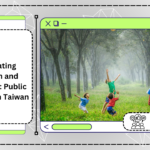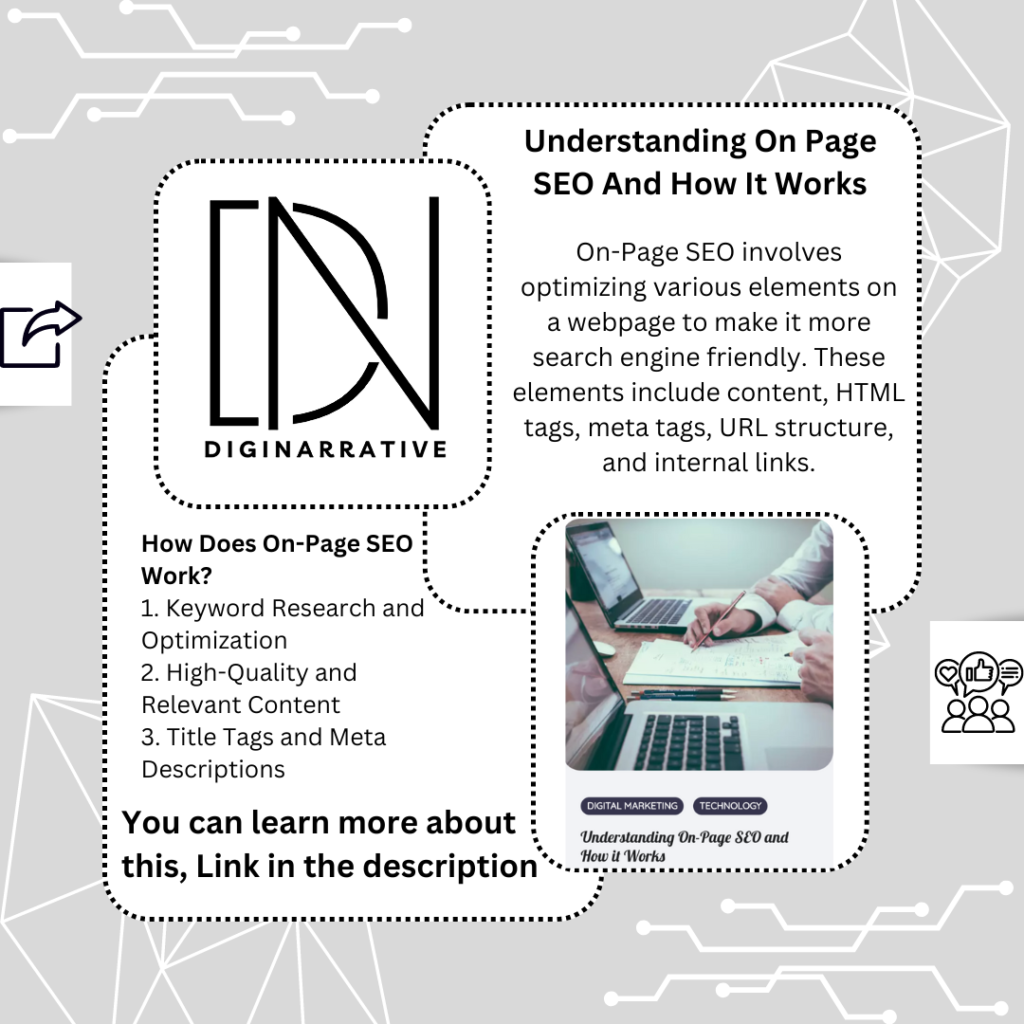When it comes to optimizing a website for search engines, one of the key strategies is On-Page SEO. This refers to the practice of optimizing individual web pages to improve their search engine rankings and attract more organic traffic. In this article, we will explore what On-Page SEO is and how it works.
What is On-Page SEO?
On-Page SEO involves optimizing various elements on a webpage to make it more search engine friendly. These elements include content, HTML tags, meta tags, URL structure, and internal links. The goal is to make it easier for search engines to understand the content and relevance of a webpage, ultimately improving its visibility in search engine results pages (SERPs).
Key Elements of On-Page SEO
Several critical factors play a role in on-page SEO. The content quality is paramount, as search engines favor original, informative, and engaging material that provides value to users. Additionally, using relevant keywords naturally within the text helps search engines understand the page’s topic. Other important aspects include optimizing title tags, meta descriptions, and header tags. These elements should include your primary keyword and enticing language to encourage clicks.
The Importance of User Experience
Aside from technical aspects, on-page SEO also involves enhancing the user experience. This includes ensuring your website loads quickly, is mobile-friendly, and has easy navigation. When users have a positive experience on your site, they are more likely to stay longer, reducing bounce rates, which contributes to higher search engine rankings. Ultimately, a well-optimized on-page strategy not only improves visibility but also fosters better engagement and conversions.
How Does On-Page SEO Work?
On-Page SEO works by focusing on optimizing different aspects of a webpage. Here are some key elements that play a crucial role in On-Page SEO:
1. Keyword Research and Optimization
Keyword research is the foundation of On-Page SEO. It involves identifying relevant keywords and phrases that users are searching for. By strategically incorporating these keywords into the content, title tags, meta descriptions, and headings, you can improve the visibility of your webpage in search results.
Understanding Keyword Research
Keyword research is a fundamental element of any effective SEO strategy. By identifying the terms and phrases that potential visitors are using to find information, products, or services, businesses can tailor their content to meet those needs. This proactive approach not only helps in improving visibility on search engines but also ensures that the content resonates with the target audience.
Importance of Optimization
Once the right keywords are identified, optimization comes into play. Optimization involves strategically placing keywords in your content, titles, meta descriptions, and headers to enhance relevance. This ensures that your web pages rank higher in search results, increasing the likelihood of attracting organic traffic. Without proper optimization, even the best content may go unnoticed, costing businesses valuable opportunities.
Best Practices for Effective Keyword Usage
To leverage keyword research effectively, businesses should focus on using a mix of short-tail and long-tail keywords. Short-tail keywords can draw a broad audience, while long-tail keywords target specific queries that potential customers may have. By crafting high-quality, informative content around these keywords, companies can establish credibility, build trust, and engage their audience more effectively.
2. High-Quality and Relevant Content
Creating high-quality and relevant content is essential for On-Page SEO. Search engines prioritize content that is informative, well-written, and offers value to users. By providing valuable content that answers users’ queries, you can increase the chances of your webpage ranking higher in search results.
Why High-Quality Content Matters
In today’s digital age, high-quality and relevant content is not just a luxury; it is a necessity. Consumers are bombarded with information, and only the most engaging and informative content manages to capture their attention. High-quality content builds trust with your audience and enhances your brand’s reputation.
How High-Quality Content Influences SEO
One of the key benefits of creating high-quality content is its positive impact on search engine optimization (SEO). Search engines favor websites that provide valuable information to users. By incorporating relevant keywords naturally into your content, you increase your chances of ranking higher in search results. Quality content naturally leads to more backlinks, driving organic traffic to your site.
Creating Content that Resonates
To produce high-quality and relevant content, it’s essential to understand your audience. What are their pain points, interests, and questions? Conducting thorough research helps in crafting content that resonates with your target demographic. Additionally, utilizing clear and concise language, along with visually appealing formatting, can enhance audience engagement.
In conclusion, investing time and resources into creating high-quality and relevant content can yield significant returns. From improving SEO to establishing trust, the benefits are profound. Start focusing on crafting valuable content today, and watch as your online presence grows.
3. Title Tags and Meta Descriptions
Title tags and meta descriptions are HTML elements that provide concise summaries of a webpage’s content. Optimizing these tags with relevant keywords and compelling descriptions can improve click-through rates and attract more organic traffic to your webpage.
Understanding Title Tags and Their Importance
Title tags are a fundamental aspect of SEO, defining the title of a webpage and appearing in search engine results. They provide a brief overview of the page’s content, aiming to grab the reader’s attention. Optimizing your title tags not only helps improve your rankings but also enhances your click-through rate.
A Deep Dive into Meta Descriptions
Meta descriptions serve as the enticing summaries of your webpages and play a crucial role in SEO. A well-crafted meta description can greatly influence click-through rates, as they give potential visitors an idea of what to expect. Ensure your meta descriptions are concise, relevant, and include call-to-action phrases to captivate your audience.
Best Practices for Crafting Effective Titles and Descriptions
When crafting title tags and meta descriptions, always prioritize clarity and relevance. Keep title tags around 60 characters and meta descriptions under 155 characters to avoid truncation in search results. Additionally, include primary keywords naturally to enhance visibility without sacrificing readability. Regularly revisiting and revising these elements can significantly contribute to your site’s SEO performance, ultimately driving more traffic and engagement.
4. URL Structure
An optimized URL structure can make it easier for search engines to understand the content of your webpage. Including relevant keywords in the URL and keeping it concise and descriptive can improve the visibility of your webpage in search results.
What is URL Structure?
URL structure refers to the way your website’s URLs are organized. It plays a vital role in user experience and search engine optimization (SEO). A well-structured URL not only helps search engines understand your content better but also enhances navigability for users.
The Importance of a Good URL Structure
A clear and descriptive URL structure can significantly impact your site’s ranking in search results. Search engines prefer URLs that are easy to read and contain relevant keywords. For instance, a URL like www.example.com/blog/seo-tips is more effective than www.example.com/12345. The former provides insights into the content, making it more likely to attract clicks.
Best Practices for Crafting URLs
1. Use Keywords: Include relevant keywords in your URLs to improve visibility. 2. Keep it Short: Shorter URLs are easier to share and remember.3. Avoid Special Characters: Stick to letters, numbers, and hyphens—they are easier for users and search engines to comprehend.4. Maintain Consistency: Use the same structure throughout your website to create a logical hierarchy.
In conclusion, a well-thought-out URL structure is crucial for both your visitors and search engines. By implementing best practices, you can enhance your website’s SEO efforts and improve user experience. Start reevaluating your URL structure today, and watch your site thrive!
5. Header Tags
Header tags (H1, H2, H3, etc.) help organize the content on a webpage and provide a hierarchical structure. By incorporating relevant keywords into header tags, you can signal the importance and relevance of the content to search engines.
Understanding Header Tags
Header tags, or H1, H2, H3 tags, are essential elements in web design and content organization. They are not just for aesthetic value; they play a significant role in improving both SEO and user experience. By structuring your content with header tags, you can create a more navigable and accessible layout for your readers.
Benefits of Using Header Tags
Utilizing header tags can significantly enhance your content’s readability. A well-structured piece makes it easier for users to skim through the material. For example, H1 tags are typically reserved for the title, while H2 and H3 tags can be used for subheadings, allowing users to find the information they need swiftly.
Moreover, search engines like Google prioritize content with proper header tagging. This helps in ranking your articles higher on search results. Header tags signal to search engines that your content is organized logically and is relevant to user searches.
Best Practices for Header Tags
When implementing header tags, always ensure that each section of your content has a unique header. This not only aids in maintaining clarity but also prevents confusion for both readers and search engines. Keep your header tags descriptive but concise, making sure to include relevant keywords that reflect the section’s content.
Incorporating header tags appropriately adds to your website’s professionalism and enhances overall user engagement. Aim for a balance between compelling headlines and practical formatting to ensure your content shines.
6. Internal Linking
Internal linking refers to linking to other pages within your website. It helps search engines discover and navigate through your website, improving its overall visibility. By strategically linking relevant pages, you can also distribute link equity and improve the ranking potential of your webpages.
Understanding Internal Linking
Internal linking refers to the process of connecting different pages within the same website through hyperlinks. This strategy is crucial for enhancing user navigation and distributing page authority across your site. By effectively using internal links, you can guide readers to related content, improving their overall experience.
Boosting SEO with Internal Links
Search engines like Google assess the relevance of your site’s content partly through internal links. Each link acts as a signal directing crawlers, making it easier for them to index your pages. By embedding internal links strategically, you can optimize your website’s SEO, ensuring that search engines understand the structure and importance of your content effectively.
Best Practices for Internal Linking
To harness the full potential of internal linking, consider the following best practices: First, use descriptive anchor text that gives users a clear idea of where the link will lead. Second, focus on linking from high-authority pages to those with lower authority to bolster their visibility. Lastly, avoid excessive linking on a single page; aim for a natural flow that enhances the reader’s journey rather than distracts them.
7. Image Optimization
Optimizing images on your webpage can improve its load time and enhance the user experience. This includes compressing images, using descriptive file names, and adding alt tags that include relevant keywords.
By implementing these On-Page SEO techniques, you can improve the visibility and ranking of your webpages in search engine results. However, it’s important to note that On-Page SEO is just one aspect of a comprehensive SEO strategy. Off-Page SEO, which includes activities such as link building and social media marketing, also plays a crucial role in improving a website’s search engine rankings.
Understanding Image Optimization
Image optimization is crucial for enhancing the speed and performance of your website. It involves reducing the file size of images without sacrificing quality. This fully ensures that your content loads quickly, which is vital for keeping your visitors engaged. In a world where attention spans are shorter than ever, every second counts.
Why Image Optimization Matters
Incorporating image optimization as part of your web strategy can significantly improve your site’s overall user experience. Search engines, like Google, favor faster websites in their rankings. This optimization not only helps in enhancing SEO but also improves accessibility for users on different devices, especially mobile.
Best Practices for Optimizing Images
To start optimizing your images, consider these best practices:
Choose the right file format: Use JPEGs for photographs and PNGs for graphics with fewer than 16 colors.
Compress images: Tools like TinyPNG and JPEGmini can significantly reduce file sizes.
Use descriptive filenames: Instead of generic names, describe the image to enhance SEO.
Implement responsive images: Use the ‘srcset’ attribute to serve appropriate images based on the user’s device.
By following these strategies, you can improve load times and create a better experience for your users. Remember, image optimization is not just an option but a necessity for a successful website.
Conclusion
On-Page SEO is an essential component of any successful SEO strategy. By optimizing various elements on a webpage, such as content, HTML tags, meta tags, URL structure, and internal links, you can improve the visibility and ranking of your webpages in search engine results. Remember to focus on providing valuable and relevant content to users, as search engines prioritize user satisfaction. By combining On-Page SEO with other SEO techniques, you can enhance your website’s overall visibility and attract more organic traffic.
Key Components of On-Page SEO
Several critical factors contribute to effective on-page SEO. First and foremost, content quality plays a significant role; it should be informative, engaging, and relevant to the target audience. Incorporating keywords strategically within your content, headings, and meta descriptions ensures that search engines recognize the purpose of your pages. Furthermore, optimizing images and implementing alt text enhances the user experience and contributes to better rankings.
Best Practices for Implementing On-Page SEO
To maximize the effectiveness of your on-page SEO efforts, adhere to best practices such as maintaining proper URL structure, utilizing header tags (H1, H2, H3) effectively, and ensuring your website is mobile-friendly. Page load speed and responsiveness are also vital, as slow-loading websites may lead to higher bounce rates, negatively impacting SEO performance. Lastly, regularly updating your content and keeping it fresh can signal to search engines that your website is active and relevant.














Pingback: Understanding Keyword Research in on page seo- DigiNarrative
Pingback: What is Off-Page SEO and How Does It Work? - DigiNarrative
Pingback: Importance of Title Tags & Meta Descriptions - DigiNarrative
Pingback: Understanding URL Structure in On-Page SEO - DigiNarrative
Pingback: What are Header Tags in On-Page SEO? - DigiNarrative
Pingback: Understanding the Power of Internal Linking - DigiNarrative
Pingback: Understanding the Link Building in Off-Page SEO - DigiNarrative
Pingback: Understanding the Role of Social Media Marketing in Off-Page SEO - DigiNarrative
Pingback: Understanding Search Engine Optimization - DigiNarrative
Pingback: Understanding Local SEO and How It Works - DigiNarrative